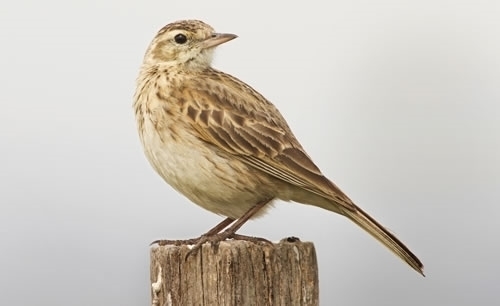The Skylark
Where is it? I can hear a beautiful lilting song, I know I’m in the right place, but against the clear blue sky I can see nothing. I lie on my back which confuses a couple of Pied Wagtails, who float over to investigate me before flying off to another corner.
The song is so loud; it seems like I should be able to find the bird easily and yet it takes a couple of minutes to pinpoint the tiny dot. When I finally get the binoculars lined up on the small male Skylark, the incredible effort required to be belting out his song whilst hovering over his territory becomes clear. He is the true harbinger of spring in the grasslands.

Skylarks are not much to look at, with their brown and streaky white upper parts and paler chest, but they are a sentinel of biodiverse grassland. This is because their diet is mainly insects but includes seeds when available. They also need small bare areas of ground and short sward patches for feeding, along with longer grass for nesting.
These factors, if present, will be maximising the species the field supports. The bird has declined hugely in the last few decades due to changing pasture practices (especially early cut silage) and an increase in pesticides, reducing its food supplies.
We set our grazing levels and silage making times around the breeding habits of this little bird. We shut up some fields for hay and don’t cut until after the 15th July which gives the birds the chance to fledge their young.
If we can get these levels right we find that the entire grassland bird community thrives, with Little Owl and Linnets making regular appearances whilst still completing our farming cycle. In the winter Short Eared Owls hunt, scaring the flocks of Redwing and Fieldfare who are working their way through the sward.
The Skylark has been heralding spring for hundreds of years and with just a little bit of help it will be doing so long into the future. Please think about getting out and helping survey these wonderful birds in February for the Big Farmland Bird Count 2016. You will be making a real difference.
The third #BFBC takes place between 6th and 14th February 2016
We're asking people to spend 30 minutes on any one day between the 6th and 14th February recording the species and number of birds seen on one particular area of the farm.
Sign up for Big Farmland Bird Count reminders >